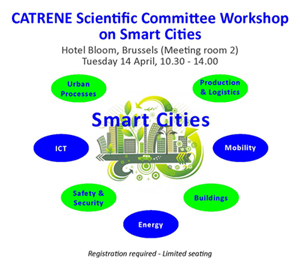SCIENTIFIC COMMITTEE WORKSHOP ON SMART CITIES
By 2050, 70 percent of the world’s population will live in cities. And, as cities grow and expand their services, the management, operations and governance across the city becomes increasingly complex. To manage this increasing complexity, it becomes necessary to make cities »smart«. Smart Cities have been defined as cities that use information and communications technology to make critical infrastructure and components and utilities more interactive and efficient. Smart cities are built on ‘smart’ and ‘intelligent’ solutions and technologies that will lead to the adoption of at least 5 of the 8 following smart parameters -smart energy, smart building, smart mobility, smart healthcare, smart infrastructure, smart technology, smart governance and smart education, smart citizen. A study on the need of “semiconductor technologies for smart cities” was performed by a working group of the CATRENE Scientific Committee. The goal was to analyse the requirement a smart city will have with respect to micro-/ nanoelectronics and smart systems for smart cities can be regarded as part of the “Internet of Things” (IoT). In this domain a huge increase in markets is expected for the next years (“The Trillion Sensor Vision”). Within this study, the key areas of interest which have been analysed are:
Future key products and roadmaps have been identified; the necessary research topics and their strategic impact have been derived. Surprisingly, it was a major outcome of this study that the expected application pull does not yet exist. There is not yet a continuous semiconductor value chain. Whereas smart city planners and operators think and act mainly on a conceptional level and utilise “off the shelves” microelectronics only, technological opportunities, although available and offered, are not really recognised by the smart city people. In addition, Smart Cities Applications today are more or less singular application solutions, since a unified Smart City approach is still lacking. . To overcome this situation some topics have been identified which might be future business cases for industry and are regarded as worthwhile to be looked at in more detail. | ||





